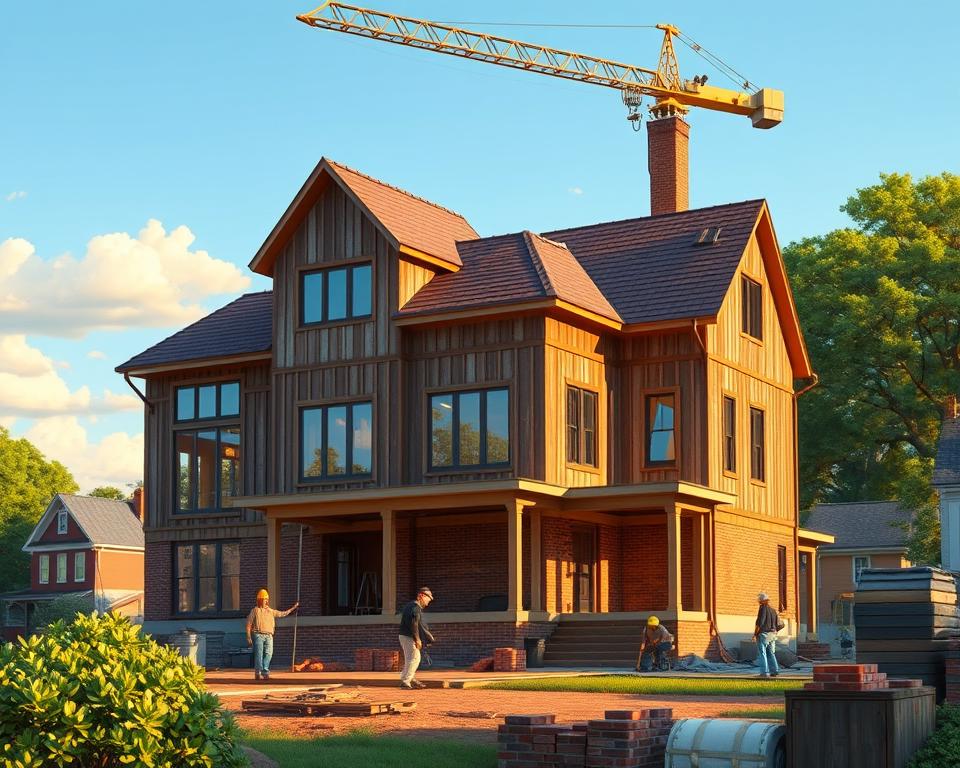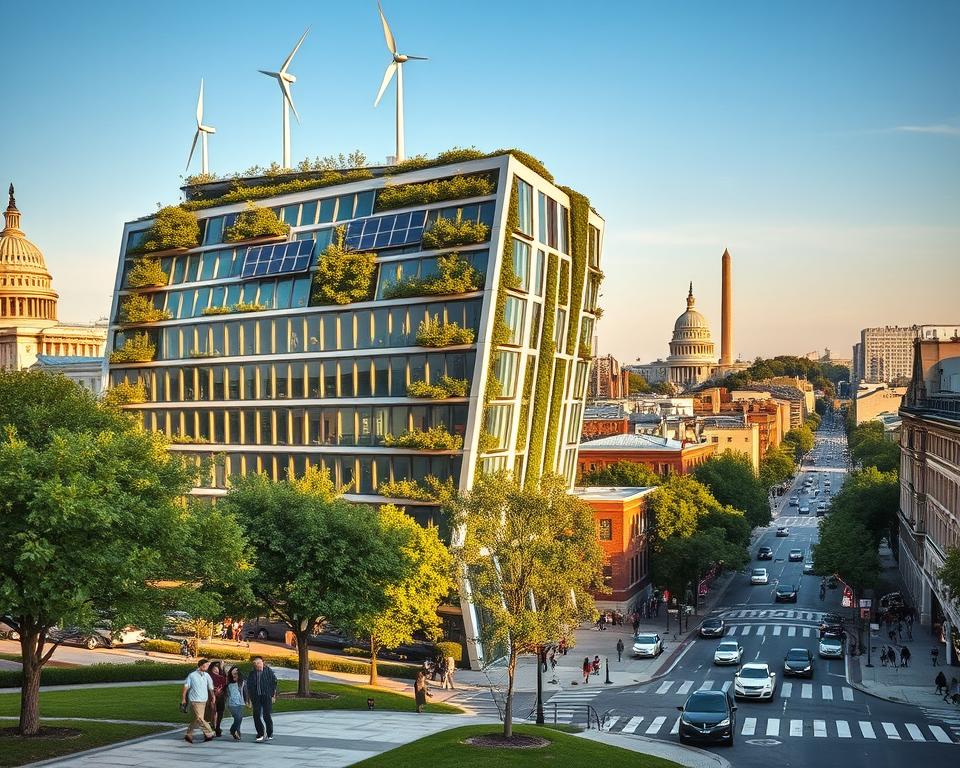Earth Bound Building: Strawbale Homebuilding in Anne Arundel
Have you heard that homes made using eco-friendly building materials may cut energy costs by up to 50%? It’s one key reason why increasing numbers of homeowners choose green building. Earth Bound Building, located in Anne Arundel, leads this movement, focused on cutting-edge and low-energy projects.
Using bio-based materials including straw bales in timber frames, Earth Bound Building builds home addition construction Anne Arundel that remain both eco-friendly and incredibly durable. This approach combines traditional craftsmanship with current green practices, ensuring every project meets the strictest standards of sustainability.
What sets Earth Bound Building apart lies in their craftsman-led approach and strong community involvement. They partner with homeowners to craft spaces that match their values and needs. If you’re looking for a eco-conscious way to build, Earth Bound Building is your trusted partner in Anne Arundel.
Understanding Straw bale Construction?
Straw, sometimes treated as waste, is revolutionizing green building. Building with straw bales uses stacking bales inside timber frames to build walls that are simultaneously thermal and structural. This method repurposes an agricultural byproduct, which makes it a renewable and low-impact choice.
Straw comes from grain crops such as wheat, rice, or barley. Instead of burning or discarding it, farmers can sell it for construction. This reduces agricultural waste and supplies a sustainable material for homes. The process is simple, making it ideal for owner-builders and community projects.
One of the standout features of straw bale walls is their insulation performance. Versus traditional materials such as fiberglass or wood, straw bales offer a higher R-value. In practice, this means they hold heat better, leading to reduced energy costs. Below is a quick comparison:

| Material | Thermal R-Value/inch |
|---|---|
| Strawbale | R-2.38 |
| Fiberglass | R-2.20 |
| Wood | R-1.41 |
Another benefit is the use of non-toxic materials. Straw bales are free from harmful chemicals, supporting healthier indoor air quality. That makes them a safe choice for families and green-minded homeowners.
In summary, straw bale construction is a low-impact, high-efficiency, and health-conscious option. It’s a great match for those looking to reduce their environmental footprint while enjoying long-term savings.
Why Select Earth Bound Building for Your Project?
Choosing the right team for your sustainable project matters greatly. Earth Bound Building is a leader in eco-friendly design, delivering modern solutions aligned with your needs. The firm’s approach blends leading techniques with a deep respect for the environment.
Commitment to Sustainability
Earth Bound Building emphasizes sustainable practices in every project. They use carbon-storing straw and low-carbon materials to lower environmental impact. In addition to ecological gains but also ensures long-term savings for homeowners.
Their collaborations with regional farmers guarantee ethically sourced materials. By backing local agriculture, they build a circular economy. This commitment to sustainability differentiates them in the industry.
Local Expertise in Anne Arundel
With strong connections in Anne Arundel, Earth Bound Building is familiar with the unique needs of the area. They are well-versed in local climate conditions, permitting processes, and supply chains. This expertise ensures smooth project execution and compliance with regulations.
Their custom designs fit Anne Arundel’s aesthetic preferences while satisfying strict building codes. Whether it’s a residential or commercial project, they deliver results that blend seamlessly with the local environment.
| Category | Earth Bound Building | Traditional Practices |
|---|---|---|
| Sourcing of Materials | Local, ethically sourced straw | Imported, high-embodied energy materials |
| Thermal Performance | High R-value insulation | Standard insulation |
| Carbon Footprint | Low carbon footprint | Higher emissions |
Earth Bound Building’s dedication to sustainability and local expertise positions them as a top pick for your next project. Their progressive practices and locally engaged approach deliver a seamless and eco-friendly experience.
The Advantages of Straw-bale Building Anne Arundel
Green building is growing rapidly for its ability to combine innovation with environmental responsibility. One of the most attractive methods in this field is the use of straw bales. This approach provides a range of benefits, from energy efficiency to eco-friendliness, making it an appealing option for modern homeowners.
Energy Efficiency and Cost Savings
Straw bale walls offer outstanding insulation, surpassing traditional materials like fiberglass. With an R-value of 2.38 per inch, they balance indoor temperatures, lowering the need for heating and cooling. This can produce energy savings of as much as 50–75%.
Over time, these savings help offset the initial construction costs. Homeowners gain lower energy bills while advancing a greener planet. Here is how straw bales measure up to other materials:
| Material | R-Value per inch |
|---|---|
| Straw Bale | R-2.38 |
| Fiberglass | R-2.20 |
| Wood | R-1.41 |
Eco-Friendly and Renewable
Straw is a renewable resource that returns each season, in contrast to timber, which requires decades to grow. Using straw in construction lowers agricultural waste and supports a circular economy. It also traps CO₂ in the walls, helping combat climate change.
Additionally, straw bale walls are low-toxin, enhancing indoor air quality. They are also fire-resistant, with plastered walls surpassing 2-hour fire ratings. This makes them a safe and sustainable choice for any project.
By choosing straw bale construction, you’re creating more than a dwelling—you’re investing in a cleaner, more sustainable future.
How Strawbale Homes Are Constructed
There are a few ways to construct sustainable homes using straw bales. Each method offers unique benefits, from structural support to faster installation. Comparing these options can help you choose the best approach for your project.
Nebraska Style vs. In-Fill Wall Systems
The Nebraska Style is a heritage method where straw-bale walls serve as the primary structural support. This approach is a great fit for smaller homes and prioritizes simplicity. The bales are stacked directly on the foundation, removing the need for additional uprights or frames.
In contrast, In-Fill Wall Systems use timber frames to take the structural load. The bales are installed within these frames, enabling faster roof installation and broader design flexibility. This method is preferred for larger projects where customization is key.
Prefabricated Straw Wall Panels
Prefabricated panels are a modern innovation in straw bale construction. These factory-built wall sections minimize on-site work and limit weather-related risks. They are designed for quick assembly, which makes them a practical choice for time-sensitive projects.
Below is a comparison of the three methods:
| Approach | Highlights | Best For |
|---|---|---|
| Nebraska Style | Load-bearing bales, simple method | Small homes |
| In-Fill Systems | Timber frames, design flexibility | Larger projects |
| Prefabricated Panels | Factory-built, reduced labor | Quick installations |
Each method has its strengths, and the choice depends on your project’s needs. Whether you lean toward traditional techniques or modern innovations, straw bale construction offers a eco-friendly and time-savvy solution.
Common Myths About Straw-bale Construction
Many people hold myths around sustainable materials like straw. These myths often prevent homeowners from exploring eco-friendly options. Let’s debunk some of the most common concerns.
Fire Resistance and Safety
One of the biggest myths is that straw is a fire hazard. In reality, compressed bales are without the oxygen needed to burn. Lab tests indicate that plastered straw walls can withstand 2+ hours of fire exposure. This exceeds the fire resistance of many traditional materials like wood.
Plaster acts as a protective barrier, encasing the bales and stopping ignition. This renders straw-based structures surprisingly safe. Here is a quick comparison:
| Material Type | Fire Resistance |
|---|---|
| Straw (plastered) | 2+ hours |
| Wood | 1 hour |
Pest and Moisture Management
Another concern is pests. Straw has no nutritional value, which discourages rodents and insects. When covered with plaster, it becomes nearly impossible for pests to penetrate. This removes one of the most common problems homeowners worry about.
Moisture is also controllable with proper design. Elevated foundations, wide eaves, and permeable finishes such as vapor-permeable stucco reduce the risk of rot. Modern techniques help ensure these houses remain durable for decades.
Compare how straw compares to traditional materials in moisture control:
| Material | Moisture Control |
|---|---|
| Straw with Proper Design | High |
| Wood without Treatment | Low |
By countering these myths, it’s clear that straw-based structures are a safe, responsible, and long-lasting choice for modern homes.
Is a Strawbale Home Right for You?
Creating a home that’s both beautiful and eco-friendly is more attainable than you might expect. With unique features such as deep window niches and curved designs, eco-friendly homes deliver endless possibilities. Consider why this is the perfect choice for you.
Customization and Aesthetic Appeal
One of the standout features of these homes is their design flexibility. You can create sculptural walls, arched doorways, and built-in shelving to match your style. The thick walls also offer strong acoustic privacy, keeping interiors tranquil.
Rustic plaster finishes add a unique charm, merging modern aesthetics with natural elements. Whether you’re an artist or an eco-conscious family, these homes can be tailored to mirror your personality and needs.
Long-Term Benefits and Sustainability
Selecting a sustainable home isn’t just about the environment—it’s also a savvy financial decision. These homes cost less to maintain over time, thanks to their energy efficiency. With decreased heating and cooling bills, you’ll see meaningful savings on utilities.
Additionally, green homes often qualify for tax incentives and command higher property values. Below is a quick comparison of lifecycle costs:
| Cost Area | Straw Bale Homes | Conventional Homes |
|---|---|---|
| Utilities | Lower | Higher |
| Maintenance | Minimal | Regular |
| Resale Value | Higher | Standard |
Earth Bound Building’s consultation process makes sure your goals align with your budget. Whether you’re planning an off-grid retreat or a family home, they’ll support you every step of the way.
In Closing
Adopting eco-friendly living starts with the right materials and the right team. Straw bale homes provide unmatched benefits, from energy efficiency to durability. They cut costs while helping the environment, which makes them a smart choice for modern homeowners.
Earth Bound Building sets the standard for green construction in Anne Arundel. Their expertise guarantees every project meets the highest standards of quality and sustainability. Choose to join the growing community of homeowners who’ve adopted this innovative approach.
Ready to take the next step? Reach out to Earth Bound Building for a personalized consultation. Attend their workshops or tour completed projects to see the benefits firsthand. Building with straw bale not only creates a residence but also strengthens regenerative agriculture and local economies.
